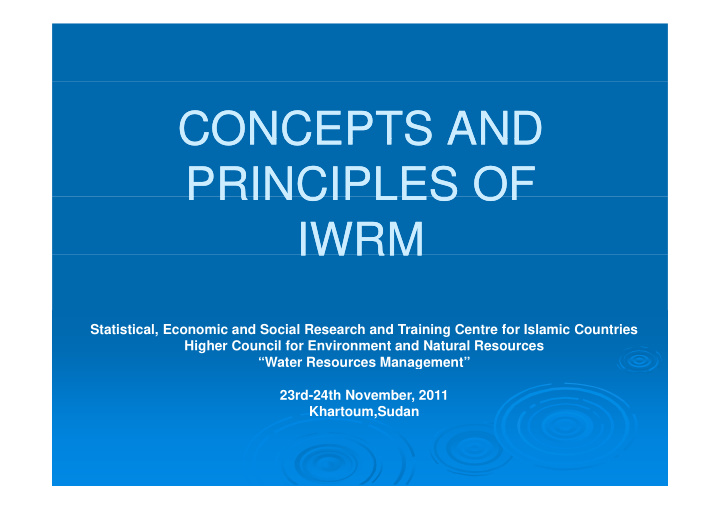



CONCEPTS AND CONCEPTS AND CONCEPTS AND CONCEPTS AND PR PR PRINC PRINC NCIPLES OF NCIPLES OF PLES OF PLES OF IWRM IWRM IWRM IWRM Statistical, Economic and Social Research and Training Centre for Islamic Countries Higher Council for Environment and Natural Resources “Water Resources Management” 23rd-24th November, 2011 Khartoum,Sudan
Objective of presentation Objective of presentation � To present brief overview of IWRM: - Concepts / general notions Concepts / general notions - Principles - Integration
Water and development Water and development � water management broader development � water management to support sustainable g pp human development � Water uses and users are interdependent � Water uses and users are interdependent � Need to engage and involve users and others affected by resource � Need to move beyond formal, hierarchical structures of management
Pressures and challenges Pressures and challenges � P � Pressures – Economic growth – Water stress Water stress – Pollution – Sectoral approach in water governance Sectoral approach in water governance � Challenges – Securing water for people, food, production Securing water for people food production and ecology – Water variability in time and space Water variability in time and space – Managing risks
Water Management Principles Water Management Principles Many water sector reforms are based on the Dublin principles (1992): 1. Fresh water 2 Water development 2. Water development 3. Women play 3 W l 4 W t 4. Water has an h is a finite and and management a central part economic value vulnerable should be based on a in the in all its resource, participatory participatory provision provision, competing uses competing uses essential to approach, management and should be sustain life, involving users, and recognised as an development planners and p safeguarding of safeguarding of economic good economic good and the policymakers at all water environment. levels
IWRM definition IWRM definition � “a process which promotes the coordinated development and management of water, p g land and related resources in order to maximize the resultant economic and to maximize the resultant economic and social welfare in an equitable manner without compromising the sustainability of vital ecosystems” Global Water Partnership (2000)
IWRM is a shift in thinking IWRM is a shift in thinking IWRM differs from traditional approaches in three ways: y � Involves cross-cutting and tries to overcome limitations of traditional sectoral approach limitations of traditional sectoral approach � Spatial focus is the river basin � Involves participatory decision making with � Involves participatory decision-making with engagement of all stakeholders ( Inclusion versus exclusion )
IWRM IWRM � ‘Classical’ WRM: ‘Cl i l’ WRM – Supply oriented, sector focused, engineering-based – Top down water master planning Top down ‘water master planning’ – Focus on water availability and development � ‘Integrated’ WRM: � Integrated WRM: – Demand-oriented, multi-sectoral approach – Addresses interaction between sub-sectors Addresses interaction between sub sectors – Considers institutional requirements – Addresses capacity building beyond water sector p y g y
IWRM IWRM � Response to increased pressure on water resource systems from population growth and y p p g economic development � Management and development of resources in � Management and development of resources in interaction with users, uses and institutions
IWRM IWRM � 3 E’s of ‘Integrated WRM : – Environmental sustainability – Equity, social – Economic efficiency – Economic efficiency � 3 additional aspects of integrated WRM : – Enabling environment (policies, legislation) – Equity, social (right access) – Economic efficiency
General framework General framework
Integration Integration � Users working together U ki t th � Hydrological cycle is a unitary one � Water quantity and quality are interrelated � “Horizontal bridging’’ of water sector and g g other economic sectors � “Vertical bridging” across spatial scales and � Vertical bridging across spatial scales and levels of decision-making � However: key words in IWRM remain � However: key words in IWRM remain ‘water resources management’
Integration Integration
Good practices from IWRM Good practices from IWRM case studies � Sound investments in water infrastructure � Strong enabling environment: goals, legislative framework, finance � Comprehensive institutional roles: institutions HR stakeholder participation institutions, HR, stakeholder participation � Effective use of available management and technical instruments d t h i l i t t
General similarities between IWRM case studies � Unitary nature water resources � Physical interventions y � Limits to physical interventions � Need for institutional framework � Need for institutional framework � role of stakeholders � balancing stakeholder interests � environmental dimension � Organisations promoting approach
Conclusion Conclusion � There is no uniform blueprint to WRM: IWRM is an approach IWRM is an approach. � This IWRM approach can only work if it is not focused exclusively on water!
THANK YOU FOR THANK YOU FOR THANK YOU FOR THANK YOU FOR YOUR ATTENTION YOUR ATTENTION YOUR ATTENTION… YOUR ATTENTION…
Recommend
More recommend